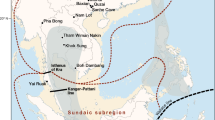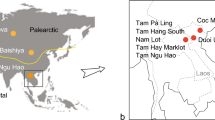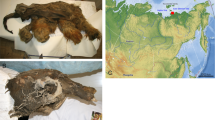Abstract
A peat deposit on Ellesmere Island1, Nunavut, Canada, allows a unique glimpse of the Early Pliocene terrestrial biota north of the Arctic Circle. The peat accumulated in a beaver pond surrounded by boreal larch forest near regional tree line2 in coastal hills close to the Arctic Ocean. The ecological affinities of the plant and beetle remains3 contained in the peat indicate that winter temperatures on Ellesmere Island were nearly 15 °C higher and summer temperatures 10 °C higher than they are today. Here we show that the mammalian remains buried in the peat represent mainly taxa of Eurasiatic zoogeographic and phyletic affinities, including the first North American occurrence of a meline badger (Arctomeles). This deposit contains direct evidence of the composition of an Early Pliocene (4–5 million years ago) arctic mammalian fauna during an active period of interchange between Asia and North America.
This is a preview of subscription content, access via your institution
Access options
Subscribe to this journal
Receive 51 print issues and online access
$199.00 per year
only $3.90 per issue
Buy this article
- Purchase on Springer Link
- Instant access to full article PDF
Prices may be subject to local taxes which are calculated during checkout


Similar content being viewed by others
References
Fyles, J. G. High terrace sediments, probably of Neogene age, west-central Ellesmere island, Northwest Territories. Curr. Res. Geol. Surv. Can. 89-1D, 101–104 (1989)
Matthews, J. V. Jr & Ovenden, L. E. Late Tertiary plant macrofossils from localities in Arctic/Subarctic North America: A review of the data. Arctic 43, 364–392 (2000)
Elias, S. A. & Matthews, J. V. Jr Arctic North American seasonal temperatures from the latest Miocene to the early Pleistocene, based on mutual climatic range analysis of fossil beetle assemblages. Can. J. Earth Sci. 39, 911–920 (2002)
Harington, C. R. Life at a 3.5 Million Year Old Beaver Pond in the Canadian Arctic Islands and the Modern Scene 11–13 (Meridian, Ottowa, 2001)
Hutchison, J. H. & Harington, C. R. A peculiar new fossil shrew (Lipotyphla, Soricidae) from the High Arctic of Canada. Can. J. Earth. Sci. 39, 439–443 (2002)
Zakrzewski, R. J. & Harington, C. R. Unusual Pliocene rodent from the Canadian Arctic Islands. J. Vert. Paleo. 21, 116A–117A (2001)
Bjork, P. R. The Carnivora of the Hagerman Local Fauna (Late Pliocene) of southwestern Idaho. Am. Phil. Soc. Trans. 60, 1–54 (1970)
Lindsay, E. et al. Recognition of the Hemphillian/Blancan boundary in Nevada. J. Vert. Paleo. 22, 429–442 (2002)
Petter, G. Origine, phylogenie et systematique des Blaireaux. Mammalia 35, 567–597 (1971)
Hulbert, R. C. & Harington, C. R. An early Pliocene hipparionine horse from the Canadian Arctic. Paleontology 42, 1017–1025 (1999)
Tedford, R. H. et al. Yushe Basin, China: Paleomagnetically calibrated mammalian biostratigraphic standard for the late Neogene of eastern Asia. J. Vert. Paleo. 11, 519–526 (1991)
Dompierre, H. & Harington, C. R. Dental microwear analysis of an Early Pliocene deerlet and hipparionine from Strathcona Fjord, Ellesmere Island, Canada. J. Vert. Paleo. 17 (suppl. 3), 43A (1997)
Rybczynski, N. & Harington, C. R. Tarsal evidence for ecomorph reconstruction in fossil lagomorphs. J. Vert. Paleo 17 (suppl. 3), 72A (1997)
Shi, N. The late Cenozoic stratigraphy, chronology, palynology and environmental development in the Yushe Basin, North China. Striae 36, 1–90 (1994)
Dowsett, H. J. et al. Middle Pliocene Paleoenvironmental Reconstruction: PRISM2 99–535 (US Geol. Surv. Rep., Washington DC, 1999)
Sher, A. V. Olyorian land mammal age of northeastern Siberia. Palaeontographica Italica 74, 77–112 (1986)
Stach, J. Arctomeles pliocaenicus new genus and species from Weze. Acta Geol. Polonica 2, 129–157 (1951)
Viret, J. Monographie paléontologique de la faune de vertébrés des Sables de Montpellier, III, Carnivora, Fissipedia. Trav. Lab. Geol. Fac. Sci. Lyon Mem. 2, 7–26 (1934)
Teilhard de Chardin, P. & Leroy, P. Les Mustélidés de Chine. Inst. Geobiol. Pékin 12, 1–56 (1945)
Roshchin, A. D. A new genus of fossil mammal of the family Mustelidae from the Pliocene of Odessa. Trudy Odeskogo Gosud. Univ. 60, 97–106 (1949)
Acknowledgements
C.R.H. is grateful to J. G. Fyles, who discovered the Beaver Pond site in 1961 and the first vertebrate remains in 1988, for introducing him to the site in 1992, and to J. S. Tener and C. C. Kennedy for field assistance. The Canadian Museum of Nature and the Polar Continental Shelf Project provided support for field work. R.H.T. thanks E. Heck for graphics and A. Lora for manuscript preparation.
Author information
Authors and Affiliations
Corresponding author
Ethics declarations
Competing interests
The authors declare that they have no competing financial interests.
Rights and permissions
About this article
Cite this article
Tedford, R., Harington, C. An Arctic mammal fauna from the Early Pliocene of North America. Nature 425, 388–390 (2003). https://doi.org/10.1038/nature01892
Received:
Accepted:
Issue Date:
DOI: https://doi.org/10.1038/nature01892
This article is cited by
-
Ecomorphology of the Early Pleistocene Badger Meles dimitrius from Greece
Journal of Mammalian Evolution (2022)
-
Evolution of woodcutting behaviour in Early Pliocene beaver driven by consumption of woody plants
Scientific Reports (2020)
-
New remains of a primitive badger from Cueva de los Toriles (Carrizosa, Castilla-La Mancha, Iberian Peninsula) suggest a new quaternary locality in the southern Iberian plateau
Journal of Iberian Geology (2020)
-
Giant beaver palaeoecology inferred from stable isotopes
Scientific Reports (2019)
-
A basal ursine bear (Protarctos abstrusus) from the Pliocene High Arctic reveals Eurasian affinities and a diet rich in fermentable sugars
Scientific Reports (2017)
Comments
By submitting a comment you agree to abide by our Terms and Community Guidelines. If you find something abusive or that does not comply with our terms or guidelines please flag it as inappropriate.



